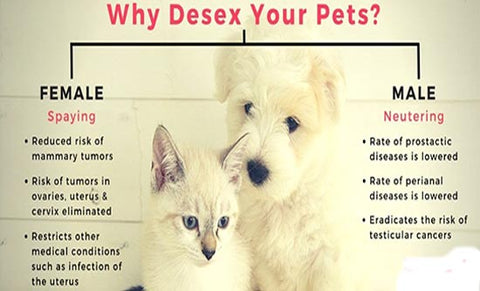Best Time to Desexing/Neutering Your Dog at Low Cost
When I meet other dog owners, one of the most frequently asked questions is desexing male dogs. Is it necessary? Are there any side effects? When it comes to desexing, many pet owners want to know what it entails and when it should be done. Here's a simple tour on desexing female or male dogs.
Both male and female dogs should be desexed since it can boost their overall health and behaviour. If not rehomed, the litters would add to the thousands of canines currently waiting for homes in shelters and rescue organisations. If a rescue group or shelter is unable to take them in, they may suffer poor care, and some may be euthanized due to being abandoned or becoming stray.
Only breeders with government permissions are exempt from desexing in areas like South Australia and the ACT. If you don't intend to breed your dog, it's probably preferable to get him neutered to ensure he stays healthy.
What is Desexing - Best Time to Desexing Your Dog
Surgical sterilising is referred to as desexing female or male dogs. Sometimes we use the term neutering as well. Females are 'spayed' by removing the ovaries and uterus, while males are 'castrated' by removing the testicles. To provide contraception and prevent various diseases, it has usually been performed around the age of six months.

However, as we gain a better understanding of the consequences of the surgery, as well as the emergence of other health conditions as a result of breeding, the issue of when to desex and what else should be handled at the same time becomes more significant. Breed and individual differences dictate how these factors are addressed. Pregnancy-related disease risk decreases as an animal's age and sexual maturity decrease.
Does Desexing Calm a Male Dog?
Can desexing female or male dogs change their behaviour? The answer is yes, but it doesn't significantly impact the outcome. A drop in testosterone and oestrogen is caused when dogs are castrated, neutered, or spayed, as the reproductive organs are removed. Removing these hormones can influence behaviour, with testosterone elimination, in particular, can lessen aggression toward other canine species.
As a prophylactic measure, it is significantly more effective. Desexing before puberty and the hormones beginning to surge may help avoid violent behaviour, but if the dog has learned aggressive behaviour, removing the hormones alone will not work.
Benefits of Desexing Your Dog
For various reasons, having your dog neutered is a wise decision. The benefits of desexing your dog can be summarised in two ways—advantages to health and other aspects of life.
Pros of Desexing Female Dogs
- Mammary tumours are less likely to occur.
- The risk of pyometra is minimised (an infection of the uterus).
- Ovarian tumours are eliminated.
- When a female dog or cat is in heat, she will not attract male dogs or cats to the home.
- You won't have to deal with the stress, tiredness, and infection that come along with having a litter.

Pros of Desexing Male Dogs
- Reduces the chance of testicular cancer.
- Decreases the possibility of perianal tumours
- Lowers the risk of prostate disease.
- It's less prone to spray pee to mark its territory and attract mates.
Other Benefits
- Trying to locate a partner, they're less likely to wander off or get hit by a car.
- In most cases, registering a desexed cat or dog with the local government is more cost-effective.
- Anti-social and violent behaviour has decreased.
- It is possible to be more tender and serene.
Dog Desexing Cost - Do Insurance Policies Cover Desexing?
Owners frequently want to know about dog desexing costs. Clinics and organisations charge different prices, but the average is thought to be between $200 and $500. In general, the overall cost depends on your dog's size, age, and other particular characteristics. The expenses of desexing female dogs may be slightly more because the surgery is more complicated and takes longer, necessitating more medicine. Depending on where you reside and the vet you visit, the cost of desexing can vary slightly.
To ensure that you can provide your dog with the best possible care, even if desexing may not always be covered by pet insurance (depending on the specific policy and circumstances), you should still consider taking out insurance for your dog. Pet insurance coverage might help you plan for unexpectedly high vet bills and keep your finances intact.
According to vets in different states, these are a few examples:
Victoria: South Eastern Animal Hospital – $220 – $285 (female)/$182 – $205 (male) in Victoria (male)
New South Wales: RSPCA NSW - between $115 and $500 (male or female)
South Australia: Dr. Ken's Veterinary Clinic - $120 - $350 (male or female)
W.A.: Hanly Veterinary Clinic - $250 to $510 (male or female)
The National Desexing Network (NDN) offers financial assistance to those who need it for desexing. Concession cardholders and other low-income pet owners can use an Australia-wide referral strategy. You can look up a veterinarian in your area and get a breakdown of their fees in their directory, but keep in mind that it is not available to all.
Why Should You Desex Your Pet?
Desexing your dog is mandatory in some states; failing to do so could result in a significant penalty. Depending on where you live, you may not be able to register your pet unless it has been spayed or neutered. Other municipalities will charge you more to register a pet that has not been desexed.
Owners of pets who haven't been spayed or neutered may be on the hook for a hefty vet charge if their animal is hurt while roaming the streets or suffers pregnancy-related issues.

Many kennels and catteries refuse to accept dogs and cats who have not been desexed while on vacation, while others charge a higher fee for doing so. Undersexed animals are also more expensive to register, costing four times as much on average.
How to Take Care of a Neutered Dog
Desexing female or male dogs might have an adverse effect on their bodies. You can help your dog's recovery from a spaying or neutering treatment be as comfortable and safe as possible by adopting the following precautions:
- If your dog appears lethargic, uncomfortable, has a decreased appetite, has diarrhoea, or is vomiting, you should take him to the vet right once.
- Make sure your dog's wound is healing correctly by checking it daily. Swelling, discharge, redness, or a filthy odour should be reported to your veterinarian right once because these are all symptoms of an infection.
- Keep your dog from licking the incision site, which could lead to infection, by making them wear a cone or other accessories. Your dog's veterinarian can help you choose the right cone for them.
- For at least ten days after surgery, do not bathe your dog.
- For up to two weeks after surgery, keep your dog from running or jumping (or longer if your vet advises).
- You should keep your dog indoors and away from other animals while they recuperate.
There are several products by Dry Paws that can help your dog recover. We would like you to read further to choose whatever you need.

Diaper: A common issue vets had to answer was whether or not a dog could wear a diaper. After desexing male dog, your dog should be able to wear a diaper. Your dog may have trouble controlling its pee after surgery. It's preferable to make them wear a diaper than to make them go potty outside regularly. Both of you will benefit from using our reusable, washable diapers. It's made of a robust but supple cloth. As a result, their skin will be softer, and the product will last longer.
Furniture Throw: One of the short-term side effects of this typical veterinary operation is weakness, which might manifest as difficulty urinating or, conversely, incontinence. There are times when even a well-trained house dog may not be able to leave the house because of exhaustion.
Don't force your dog to go outside if you see that your dog is having difficulty going outside. Instead, place furniture throws about the home to make cleanups a little easier. Our pad can cover any furniture, playpen, or crate, aside from the fact that it won't contaminate your home. It can also be washed in the washing machine.
Play Pen: Restriction of the animal's movements is critical following any surgical procedure, including desexing female dogs. This might be a challenge, especially if you have a young and active dog. We strongly advise you to get a playpen and confine him to it as much as you can. If the wound is to heal correctly, you must do what seems like a punishment. There's plenty of room in our playpen for bedding, treats, food, and other miscellaneous items. It is lightweight and foldable to make the recovery process as simple as possible.
Mesh Gate: They cannot be kept in a playpen all the time, can they? A mesh gate, on the other hand, can be used to keep your pets from running. You can prevent your dog from going outside by blocking the stairs or the door. Because our gate is see-through, you can keep an eye on him at all times. As the name suggests, it's a no-drill-mesh security barrier. This means that you can use it with any wall, at any time.
Calming Pet Bed: Having surgery can be physically and emotionally draining. Your dog will require adequate rest to recover properly. All of your dog's needs for warmth will be met by our calming pet bed. It's incredibly delicate and comfy. Extra padding and gorgeous vegan faux fur are used to make it. In addition to being machine washable, it can be dried in the sun. To preserve the quality, avoid bleaching, dry cleaning, and ironing. There are four sizes available. Make the decision that is best for you and your pet!
Nylon Leash: The dog may walk perfectly off-leash, but if he is given a chance to run or climb, these activities can cause his incision to re-open, further complicating his recovery. Until his wound is entirely healed, it is far safer to have your canine buddy on a leash while out on a stroll. Dry Paws' nylon leash is constructed of durable materials. It has a non-slip sponge handle. Because of this, it is simple to grab. Nylon webbing is used for the leash's construction. As a result, it will be unaffected by your dog's misbehaviour. And the buckle is made of zinc alloy. It's a sturdy leash because of these three components. You can carry anything else you need, including your phone and contact information, with an accessory clip.
Snuffle Mat: Your dog may become bored if confined to the playpen for an extended period. Even though he can't move normally, puzzle toys can keep him occupied while he recuperates. A snuffle mat from Dry Paws, which has treats tucked inside, is an excellent method to keep his mind entertained while his body is resting. Dog snuffle mats usually are flat and composed of fleece. The fabric strips are braided through a sturdy backing and knotted at the top to make the mat's fingers. It's more fun with the fingers. It's also sewn correctly, so there's no risk of choking.
Desexing Male Dogs - What Should be Your Final Decision?
We hope you've gotten all of your questions concerning desexing male dogs answered. However, make an appointment with your veterinarian to get an accurate assessment of your pet's condition.
Even if you're still unsure, desexing female dogs lowers their risk of developing different cancers, including breast cancer and uterine disorders. Female dogs that have not been sterilised, on the other hand, can build pyometra, and male dogs who have not been neutered are in danger of developing testicular cancer. Because it prevents animals from suffering and minimises the number of pups without loving homes, sterilisation is a civic duty. So visit your veterinarian and make an informed decision.
















